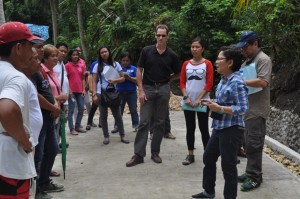
Delegates from the World Bank (WB) and the Asian Development Bank (ADB) commended local communities in two Quezon towns for their active volunteerism and ownership of the Department of Social Welfare and Development’s Kapit Bisig Laban sa Kahirapan-Comprehensive and Integrated Delivery of Social Services (Kalahi-CIDSS) program.
This is during the implementation support mission of the said delegates in the towns of Catanauan and Buenavista last October 6-9, 2015.
The mission includes sub-project visit and interaction with community volunteers and local government officials of Brgys. Ajos and Tagbacan Ilaya in Catanauan and Brgys. Hagonghong and Del Rosario in Buenavista.
The WB and the ADB are the development partners and funding agencies of the DSWD’s Kalahi-CIDSS program.
“As a development partner of this program, it is important for us to see where the Kalahi-CIDSS program is heading and how it helps the community directly from the stories of the local residents,” said Sean Bradley, the Senior Social Development Specialist of the WB.
For the year 2015, the WB allocated PhP115.36 Million to fund 197 sub-projects in Quezon Province. On the other hand, ADB provided PhP250.42 Million to finance 433 sub-projects.
Voices of local residents, LGUs on CDD
Victoria Rejano, the tribal chieftain of the Aeta community in Brgy. Del Rosario in Buenavista town, shared that they have learned to take part in community activities and interact with the other residents of the barangay through the Kalahi-CIDSS program.
Rejano and some members of the Aeta community became volunteers in the installation of water system and construction of farm-to-market road in their barangay. Now, they are implementing a tribal hall sub-project where the Aetas can regularly hold their activities and ceremonies.
“Kung hindi kami makikiisa sa buong barangay, hindi rin uunlad ang aming tribo. Sa pagtutulungan pala ay matutugunan ang pangangailangan ng bawat isa,” said Rejano to the visitors.
On the other hand, Mayor Ramon Orfanel of Catanauan acknowledged the Kalahi-CIDSS program for shaping community residents as active participants on the local development process. He added that the LGU officials are also reviewing the CDD strategy so they can apply it in their barangay and municipal projects’ implementation.
“We ensure that the other projects identified by the local residents during Kalahi-CIDSS activities will be implemented through the other programs of the LGU. We wanted these projects to be implemented as these are raised directly by the residents and are sure to respond to their needs,” said Mayor Orfanel.
Strong CDD implementation
ADB Consultant Alice Tiongson observed that the projects are well-sustained in the areas. She commended the operations and maintenance group formed by the community volunteers along with their own sustainability plans for the projects.
“The volunteerism amongst the community residents is very much evident in the barangays. There is a sense of ownership in the projects and they make their own ways to maintain and further improve their projects,” said Tiongson.
On the other hand, WB Consultant Corrine Canlas noted that the barangay and municipal LGUs have already grasped the CDD approach in their own levels.
“If the LGUs have adopted well the CDD strategy, we can ensure the continuation of this process at the local level even without the Kalahi-CIDSS program. People will continue to be empowered to improve their own communities,” said Canlas.
The Kalahi-CIDSS is a poverty reduction program of the DSWD that aims to improve the delivery of social services in poor communities by engaging ordinary citizens in the local development process. In the CALABARZON Region, it is being implemented in the 20 municipalities in Quezon Province.#
